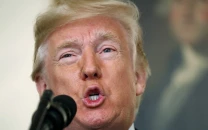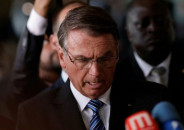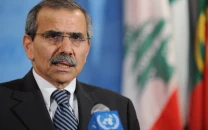US-China partial trade deal: the main points
The signing could take place in the middle of November in Chile on the sidelines of APEC summit

Vice Premier of the People's Republic of China Liu He shakes hands with US President Donald Trump. PHOTO: AFP
Here are the main points of the agreement, which has yet to be signed.
Trump said he hoped to have a deal signed with President Xi Jinping "in four weeks, five weeks, something like that."
The signing could take place in the middle of November in Chile on the sidelines of the Asia-Pacific Economic Cooperation (APEC) summit.
Dollar weakens as hopes for US-China trade deal fade
"We have a fundamental understanding on the key issues... but there is more work to do," Treasury Secretary Steven Mnuchin told reporters.
"We will not sign an agreement unless we get, and can tell the president, that this is on paper."
Mnuchin said Liu needed "to go back to do some work with his team, but we have made a lot of progress over the last two days," signalling that approval from the highest level in Beijing would be sought.
Previous apparent breakthroughs have faced opposition in Beijing and seen a resumption of the trade war.
China has pledged to rapidly increase purchases of US farm goods to $40-50 billion a year -- a sharp rise that would be more than double the level in 2017.
In 2017, before the trade war started, China imported $19.5 billion of US farm output, falling to just over $9 billion in 2018.
"We've had good discussions with... the head of the People's Bank of China, their central bank," Mnuchin said Friday.
"We have also had extensive discussions on financial services opening up their markets to our financial services firms. So we have pretty much almost a complete agreement on both of those issues.
"Currency has been a very big concern... and we have an agreement around transparency into the foreign exchange markets and free markets, so we are very pleased with that."
The US Treasury in August branded China a currency manipulator, accusing Beijing of deliberately weakening the yuan to gain unfair trade advantages.
Trump said the talks had "made very good progress on technology transfer" -- a key point of friction.
Without giving further details, he said an agreement could be reached soon, with US companies sharing their know-how in exchange for access to Chinese markets.
US prefers a 'big deal' with China: Trump
"We have an agreement on intellectual property," the US president said, claiming another obstacle to an overall deal had been overcome.
US chief negotiator Trade Representative Robert Lighthizer said a dispute settlement mechanism was being finalised.
The mechanism is seen as essential by the United States to enforcing any agreement.
Lighthizer said the next round of tariffs due to hit on December 15 could be cancelled.



















COMMENTS
Comments are moderated and generally will be posted if they are on-topic and not abusive.
For more information, please see our Comments FAQ